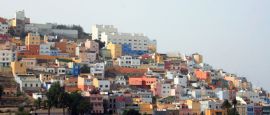Getting around Gran Canaria
There are no internal flights on the island, but travellers can fly from Gran Canaria to other Canary Islands with BinterCanarias (www.bintercanarias.com) and CanaryFly (www.canaryfly.es).
A car offers the greatest flexibility for getting around Gran Canaria. Around Las Palmas the motorway can get busy during rush hour, but beyond the capital traffic is light and driving is a pleasure.
Watch for unusual use of the indicator; it's rarely used to notify a directional change and usually in place of hazard warning lights or to advise that the car is stopping at a pedestrian crossing. On roundabouts, which are still something of a mystery to local drivers, it's best to stick to the outside lane or risk getting cut up when you try to exit.
Highways are generally well-maintained and well sign-posted, but the mountain roads can be steep and narrow.
The island has four stretches of motorway – GC1, GC2, GC3 and GC4 – which are toll-free, plus a network of single carriageway roads which crisscross the island. Some mountain roads are only wide enough for one vehicle, so exercise caution when driving on them.
Car hire is good value in Gran Canaria. Several major car hire companies are represented at the two airports and in urban centres, but many firms operate from industrial estates outside the airport and offer a shuttle bus to and from the airport. Drivers must be over 21 to hire a car and you will need a passport, driving licence and credit card.
Taxis on Gran Canaria are metered and well regulated. They can be found at the airport and ferry terminals, as well as in all resorts and major centres.
Riders of motorcycles over 75cc must be at least 18. Crash helmets are compulsory. Cycling is popular in Gran Canaria and bikes are widely available for hire, but cycle lanes are few and far between.
The island is well served by the local bus service. Routes, timetables and fares are available on the website (www.globalsu.es).
Two red hazard triangles and two reflective vests or jackets must be kept in all vehicles – the latter in the car, not in the boot. Parking laws are rigorously enforced and towing is prevalent. The speed limit for motorways is 120kph (80mph). In built-up areas it's 50kph (30mph) and on other roads it's 90kph (56mph).
Speed cameras are in operation on motorways and major roads. Front and rear safety belts are compulsory. Drink driving is a serious offence in Gran Canaria. The legal limit is just 0.05%. The use of a mobile phone whilst driving is classed as a serious offence.
Real Automóvil Club de España (RACE) (tel: +34 900 112 222; www.race.es).
Most foreign licences, including Canadian, EU and US, are accepted. Minimum third Party insurance is compulsory. An original driving licence, proof of insurance and another piece of identification must be carried in the car at all times.
The main resorts are relatively flat, compact and easily navigable on foot, except for Puerto Rico, which is built on a hill. The public bus service is a cheap, safe and reliable way of travelling.
Do you have any Feedback about this page?
© 2025 Columbus Travel Media Ltd. All rights reserved. No part of this site may be reproduced without our written permission, click here for information on Columbus Content Solutions.




 You know where
You know where